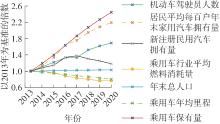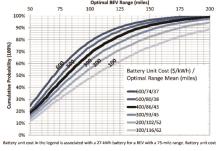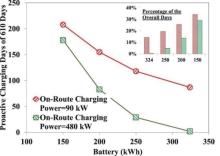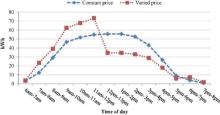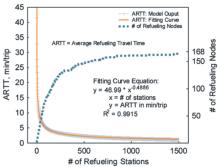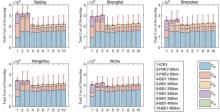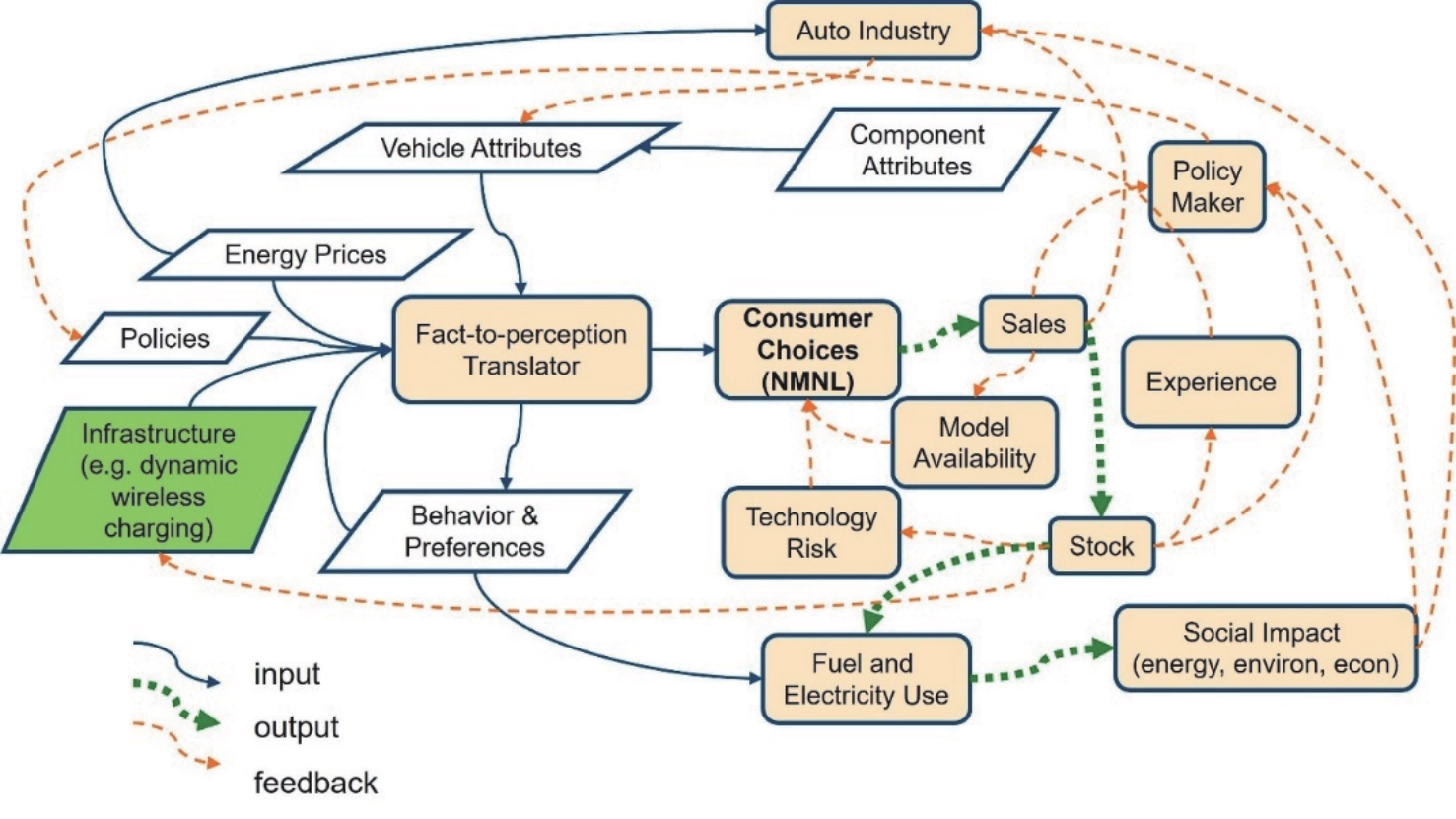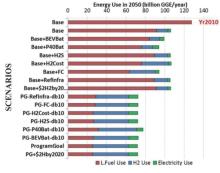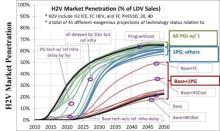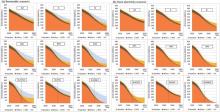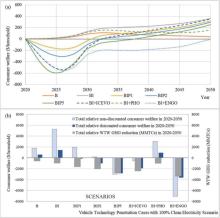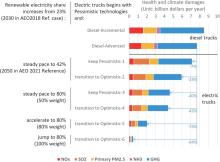华南理工大学学报(自然科学版) ›› 2025, Vol. 53 ›› Issue (1): 32-48.doi: 10.12141/j.issn.1000-565X.240238
交通能源转型决策分析综述
陈翠峰1, 林镇宏1,2, 黄炽坤1, 赵津瑶1, 欧士琪1,2
- 1.华南理工大学,广东 广州 510006
2.人工智能与数字经济广东省实验室(广州),广东 广州 510335
-
收稿日期:2024-05-20出版日期:2025-01-25发布日期:2025-01-02 -
通信作者:林镇宏(1977—),男,博士,教授,博士生导师,主要从事能源转型、能源决策与分析、交通工程等研究。 E-mail:zhenhong@scut.edu.cn -
作者简介:陈翠峰(1977—),女,助理研究员,主要从事党建与思想政治、交通强国思想与建设实践研究。E-mail: cfchen@scut.edu.cn -
基金资助:国家自然科学基金项目(52072130);广东省基础与应用基础研究基金项目(2024A1515010740)
Review of Decision-Making Analysis for Transportation Energy Transition
CHEN Cuifeng1, LIN Zhenhong1,2, HUANG Chikun1, ZHAO Jinyao1, OU Shiqi1,2
- 1.South China University of Technology,Guangzhou 510006,Guangdong,China
2.Guangdong Artificial Intelligence and Digital Economy Laboratory (Guangzhou),Guangzhou 510335,Guangdong,China
-
Received:2024-05-20Online:2025-01-25Published:2025-01-02 -
Contact:林镇宏(1977—),男,博士,教授,博士生导师,主要从事能源转型、能源决策与分析、交通工程等研究。 E-mail:zhenhong@scut.edu.cn -
About author:陈翠峰(1977—),女,助理研究员,主要从事党建与思想政治、交通强国思想与建设实践研究。E-mail: cfchen@scut.edu.cn -
Supported by:the National Natural Science Foundation of China(52072130);Guangdong Basic and
摘要:
实现交通强国目标要求高度发展基础设施、构建高效运营体系、推动技术创新和实现可持续发展。在双碳目标这一背景下,交通部门需通过能源转型实现深度减碳,这既符合交通强国构建过程中的可持续发展要素,也需要避免因能源转型决策错误或过于急切而对交通基础设施、运营体系的资源配置产生负面影响,从而影响交通强国战略的顺利推进。交通能源转型涉及多个关键决策变量,如汽车动力技术、基础设施建设、用户行为和政策制定等,其复杂性和重要性不容忽视。该文旨在从交通强国和双碳目标相融合的角度,结合综述和案例研究,深入探讨交通能源转型决策分析的意义、方法、工具和经验,为国家政策的制定和企业决策提供理论与实践参考,引发对相关决策分析的重视和研究。首先,对交通能源转型决策分析的内涵和动机进行了阐述。然后,从汽车动力技术、基础设施、用户行为和政策制定4个角度出发,运用优化模型思维方法,并引用已有文献中的分析案例进行详细示范,涵盖诸如电动车辆行驶里程优化、充电网络规划、用户选择行为决策、政策减排效益及公平性等内容。此外,借助已发表的案例或政策实施情况,着重指出了交通能源转型决策分析中不当假设可能对行业和社会产生的影响。最后,总结了交通能源转型决策分析的重要性和可操作性,提出了若干研究课题建议,以促进该领域的深入研究。该文研究内容可为交通能源转型决策提供全面的理论支持和实践参考,有利于推动我国交通领域的可持续发展。
中图分类号:
引用本文
陈翠峰, 林镇宏, 黄炽坤, 赵津瑶, 欧士琪. 交通能源转型决策分析综述[J]. 华南理工大学学报(自然科学版), 2025, 53(1): 32-48.
CHEN Cuifeng, LIN Zhenhong, HUANG Chikun, ZHAO Jinyao, OU Shiqi. Review of Decision-Making Analysis for Transportation Energy Transition[J]. Journal of South China University of Technology(Natural Science Edition), 2025, 53(1): 32-48.
| 1 | International Energy Agency .Explore energy data by ca-tegory,indicator,country or region[DB/OL].(2019-09-22)[2020-02-03].. |
| 2 | 侯梅芳 .碳中和目标下中国能源转型和能源安全的现状、挑战与对策[J].西南石油大学学报(自然科学版),2023,45(2):1-10. |
| HOU Meifang .Current situation, challenges and countermeasures of China’s energy transformation and energy security under the goal of carbon neutrality[J].Journal of Southwest Petroleum University (Science & Technology Edition),2023,45(2):1-10. | |
| 3 | 潘家华,董秀成,崔洪建,等 .欧洲能源危机及其影响分析[J].国际经济评论,2023(1):9-37. |
| PAN Jiahua, DONG Xiucheng, CUI Hongjian,et al .Analysis of European energy crisis and its impact[J].International Economic Review,2023(1):9-37. | |
| 4 | 刘仁厚,杨洋,丁明磊,等 .“双碳”目标下我国绿色低碳技术体系构建及创新路径研究[J].广西社会科学,2022(4):8-15. |
| LIU Renhou, YANG Yang, DING Minglei,et al .Research on the construction and innovation path of China’s green and low-carbon technology system under the goal of “double carbon”[J].Social Sciences in Guangxi,2022(4):8-15. | |
| 5 | 刘召峰,周冯琦 .全球城市之东京的环境战略转型的经验与借鉴[J].中国环境管理,2017,9(6):103-107. |
| LIU Zhaofeng, ZHOU Fengqi .The study on environment strategies transition of global city: the case of Tokyo[J].Chinese Journal of Environmental Management,2017,9(6):103-107. | |
| 6 | 张扬 .欧洲四国“绿色交通”考察(上)[J].交通与运输,2017,33(4):60-62. |
| ZHANG Yang .Study on “Green Transportation” in four European countries (Ⅰ)[J].Traffic & Transportation,2017,33(4):60 -62. | |
| 7 | 《乘用车燃料消耗量限值》强制性国家标准发布[J].环境技术,2021,39(1):5. |
| The mandatory national standard for fuel consumption li-mits for passenger vehicles was issued[J].Environmental Technology,2021,39(1):5. | |
| 8 | 朱星华,纽约州支持电动汽车发展的政策举措及其启示[J].全球科技经济瞭望,2014,29(6):13 -17. |
| ZHU Xing-hua .New York’s policies and initiatives on developing electric vehicles[J].Global Science,Technology and Economy Outlook,2014,29(6):13 -17. | |
| 9 | 刘佳佳,左兴权 .交叉口交通信号灯的模糊控制及优化研究[J].系统仿真学报,2020,32(12):2401-2408. |
| LIU Jiajia, ZUO Xingquan .Research on fuzzy control and optimization for traffic lights at single intersection[J].Journal of System Simulation,2020,32(12):2401-2408. | |
| 10 | 邹柠羽,朱家群,王学安 .城市停车标志交叉口交通信号灯智能控制仿真[J].计算机仿真,2019,36(3):189-192. |
| ZOU Ning-yu, ZHU Jia-qun, WANG Xue-an .City tra-ffic sign intersection signal light intelligent control simulation[J].Computer Simulation,2019,36(3):189-192. | |
| 11 | 敖仪斌,郑俊杰,肖珊,等 .农村居民交通行为研究方法、趋势与热点综述[J].华南理工大学学报(自然科学版),2023,51(10):31-45. |
| AO Yibin, ZHENG Junjie, XIAO Shan,et al .Review of research methods,trends and hotspots on rural residents’ transportation behavior[J].Journal of South China University of Technology (Natural Science Edition),2023,51(10):31-45. | |
| 12 | 严军华,王舒笑,袁浩然,等 .电动汽车能耗与气体排放分析及环境影响评价[J].华南理工大学学报(自然科学版),2018,46(6):137-144. |
| YAN Junhua, WANG Shuxiao, YUAN Haoran,et al .Life cycle assessment of energy consumption with emission and environmental impact of electric vehicle[J].Journal of South China University of Technology (Natural Science Edition),2018,46(6):137-144. | |
| 13 | ARIAS D A, SHEDD T A, JESTER R K .Theoretical analysis of waste heat recovery from an internal combustion engine in a hybrid vehicle[J].SAE Technical Paper,2006:777-784. |
| 14 | SUN Z, HEBBALE K .Challenges and opportunities in automotive transmission control[C]∥Proceedings of the 2005,American Control Conference.[S.l.]:IEEE,2005:3284-3289. |
| 15 | LIU H, HAN L, CAO Y .Improving transmission efficiency and reducing energy consumption with automotive continuously variable transmission:a model prediction comprehensive optimization approach[J].Applied Energy,2020,274:115303/1-13. |
| 16 | WAHEDI Y AL, TORRES A I, HASHIMI S AL,et al .Economic assessment of temperature swing adsorption systems as Claus tail gas clean up units[J].Chemical Engineering Science,2015,126:186-195. |
| 17 | LUO Y, TAN D .Study on the dynamics of the in-wheel motor system[J].IEEE Transactions on Vehicular Technology,2012,61(8):3510-3518. |
| 18 | LI J, XIE C, BAO Z .Optimal en-route charging station locations for electric vehicles: a new modeling perspective and a comparative evaluation of network-based and metanetwork-based approaches[J].Transportation Research Part C:Emerging Technologies,2022,142:103781/1-46. |
| 19 | OU S, ZHANG S, LIN Z,et al .A method for determining optimal electric range by considering electric vehicle lightweighting on perceived ownership cost[J].Journal of Cleaner Production,2023,385:135606/1-40. |
| 20 | LIN Z .Optimizing and diversifying electric vehicle driving range for U.S. drivers[J].Transportation Science,2014,48(4):635-650. |
| 21 | LIN Z, XIE F,OU S .Modeling the external effects of air taxis in reducing the energy consumption of road traffic[J].Transportation Research Record,2020,2674(12):176-187. |
| 22 | GAO Z, LIN Z, LACLAIR T J,et al .Battery capacity and recharging needs for electric buses in city transit service[J].Energy,2017,122:588-600. |
| 23 | BRONIEWICZ E, OGRODNIK K .Multi-criteria analysis of transport infrastructure projects[J].Transportation Research Part D: Transport and Environment,2020,83:102351/1-15. |
| 24 | SONG S, LI T, LIU P,et al .The transition pathway of energy supply systems towards carbon neutrality based on a multi-regional energy infrastructure planning approach: a case study of China[J].Energy,2022,238:122037/1-10. |
| 25 | GILLESSEN B, HEINRICHS H, HAKE J F,et al .Natural gas as a bridge to sustainability: infrastructure expansion regarding energy security and system transition[J].Applied Energy,2019,251:113377/1-16. |
| 26 | BI C, JIA M, ZENG J .Nonlinear effect of public infrastructure on energy intensity in China:a panel smooth transition regression approach[J].Sustainability,2019,11(3):629/1-21. |
| 27 | 孙传旺,罗源,姚昕 .交通基础设施与城市空气污染——来自中国的经验证据[J].经济研究,2019,54(8):136-151. |
| SUN Chuanwang, LUO Yuan, YAO Xin .The effects of transportation infrastructure on air quality:evidence from empirical analysis in China[J].Economic Research Journal,2019,54(8):136-151. | |
| 28 | 泮楚微,杨传明 .交通基础设施、经济高质量发展与碳排放复杂关联分析[J].中国储运,2024(5):158-159. |
| PAN Chuwei, YANG Chuanming .Complex correlation analysis of transportation infrastructure,high-quality economic development and carbon emissions[J].China Storage & Transport,2024(5):158-159. | |
| 29 | PETERSON D .Addressing challenges to electric vehicle charging in multifamily residential buildings[R].Los Angeles:UCLA Luskin School of Public Affairs,2011. |
| 30 | LI S, XIE F, HUANG Y,et al .Optimizing workplace charging facility deployment and smart charging strategies[J].Transportation Research Part D:Transport and Environment,2020,87:102481/1-12. |
| 31 | 施博文,余敏,许晓敏,等 .“双碳”目标下超大型城市氢能汽车的应用[J].信息与管理研究,2023,8(2/3):40-51. |
| SHI Bowen, YU Min, XU Xiaomin,et al .Hydrogen vehicle application in super-large cities on dual carbon target[J].Journal of Information and Management,2023,8(2/3):40-51. | |
| 32 | LIN Z, OGDEN J, FAN Y,et al .The fuel-travel-back approach to hydrogen station siting[J].International Journal of Hydrogen Energy,2008,33(12):3096-3101. |
| 33 | GUO Y, SOUDERS D, LABI S,et al .Paving the way for autonomous vehicles: understanding autonomous vehicle adoption and vehicle fuel choice under user heterogeneity[J].Transportation Research Part A:Policy and Practice,2021,154:364-398. |
| 34 | JIAN S, RASHIDI T H, DIXIT V .An analysis of carsharing vehicle choice and utilization patterns using multiple discrete-continuous extreme value (MDCEV) mo-dels[J].Transportation Research Part A:Policy and Practice,2017,103:362-376. |
| 35 | GOLOB T F, BUNCH D S, BROWNSTONE D .A vehicle use forecasting model based on revealed and stated vehicle type choice and utilisation data[J].Journal of Transport Economics and Policy,1997,31(1):69-92. |
| 36 | ANDERSON J E, LEHNE M, HARDINGHAUS M .What electric vehicle users want:real-world preferences for public charging infrastructure[J].International Journal of Sustainable Transportation,2018,12(5):341-352. |
| 37 | SHBEEB L .How users perceive infrastructure development affects their transport mode choice[J].Journal of Transportation Technologies,2023,13(4):545-598. |
| 38 | HAO X, LIN Z, WANG H,et al .Range cost-effectiveness of plug-in electric vehicle for heterogeneous consumers:an expanded total ownership cost approach[J].Applied Energy,2020,275:115394/1-19. |
| 39 | DONG J, LIN Z .Within-day recharge of plug-in hybrid electric vehicles: energy impact of public charging infrastructure[J].Transportation Research Part D,2012,17(5):405-412. |
| 40 | GREIM P, SOLOMON A A, BREYER C .Assessment of lithium criticality in the global energy transition and addressing policy gaps in transportation[J].Nature Communications,2020,11(1):4570/1-11. |
| 41 | REHMAN F U, ISLAM M M, MIAO Q .Environmental sustainability via green transportation:a case of the top 10 energy transition nations[J].Transport Policy,2023,137:32-44. |
| 42 | SOLOMON B D, KRISHNA K .The coming sustainable energy transition:History,strategies,and outlook[J].Energy Policy,2011,39(11):7422-7431. |
| 43 | MARKARD J .The next phase of the energy transition and its implications for research and policy[J].Nature Energy,2018,3(8):628-633. |
| 44 | LINDBERG M B, MARKARD J, ANDERSEN A D .Policies, actors and sustainability transition pathways:a study of the EU’s energy policy mix[J].Research policy,2019,48(10):103668/1-15. |
| 45 | HAN S, ZHANG B, SUN X,et al .China’s energy transition in the power and transport sectors from a substitution perspective[J].Energies,2017,10(5):600/1-25. |
| 46 | LIN Z, DONG J, GREENE D L .Hydrogen vehicles: impacts of DOE technical targets on market acceptance and societal benefits[J].International Journal of Hydrogen Energy,2013,38(19):7973-7985. |
| 47 | OU S, LIN Z, JIANG Y,et al .Quantifying policy gaps for achieving the net-zero GHG emissions target in the U.S. light-duty vehicle market through electrification[J].Journal of Cleaner Production,2022,380(P2):135000/1-13. |
| 48 | DOMINKOVIĆ D F, BAČEKOVIĆ I, PEDERSEN A S,et al .The future of transportation in sustainable energy systems: opportunities and barriers in a clean energy transition[J].Renewable and Sustainable Energy Reviews,2018,82:1823-1838. |
| 49 | BOGDANOV D, GULAGI A, FASIHI M,et al .Full energy sector transition towards 100% renewable energy supply: integrating power, heat, transport and industry sectors including desalination[J].Applied Energy,2021,283:116273/1-17. |
| 50 | HANSEN K, BREYER C, LUND H .Status and perspectives on 100% renewable energy systems[J].Energy,2019,175:471-480. |
| 51 | PYE S, SABIO N, STRACHAN N .An integrated systematic analysis of uncertainties in UK energy transition pathways[J].Energy Policy,2015,87:673-684. |
| 52 | SALTELLI A, ANNONI P .How to avoid a perfunctory sensitivity analysis[J].Environmental Modelling & Software,2010,25(12):1508-1517. |
| 53 | TONG F, JENN A, WOLFSON D,et al .Health and climate impacts from long-haul truck electrification[J].Environmental Science & Technology,2021,55(13):8514-8523. |
| 54 | LIN Z .Mostly positive implications of long-haul truck electrification[J].Joule,2021,5(10):2548-2550. |
| 55 | OU S, LIN Z, WANG C .Improving the effectiveness and equity of fuel economy regulations with sales adjustment factors[J].iScience,2022,25(9):104902/1-22. |
| 56 | US Department of Transportation .National Household Travel Survey[R].Washington D C:US Department of Transportation,2017. |
| 57 | OU S, YU R, LIN Z,et al .Intensity and daily pattern of passenger vehicle use by region and class in China:estimation and implications for energy use and electrification[J].Mitigation and Adaptation Strategies for Global Change,2019,25(3):307-327. |
| 58 | ZHENG S, HUO Y .Low carbon urban spatial structure: a study from the personal vehicle travel perspective[J].World Econ Pap,2010(6):50-65. |
| 59 | GREENE D L, WELCH J G .Impacts of fuel economy improvements on the distribution of income in the U.S.[J].Energy Policy,2018,122:528-541. |
| 60 | 李丹阳,陈文颖 .碳中和目标下全球交通能源转型路径[J].气候变化研究进展,2023,19(2):203-212. |
| LI Dan-yang, CHEN Wen-ying .Global transportation energy transition pathways towards carbon neutrality[J].Climate Change Research,2023,19(2):203-212. |
| [1] | 蔡泽祥 马国龙 孙宇嫣 黄昱翰. 基于数据挖掘的电力设备运维与决策分析方法[J]. 华南理工大学学报(自然科学版), 2019, 47(6): 57-64,71. |
| 阅读次数 | ||||||
|
全文 |
|
|||||
|
摘要 |
|
|||||
